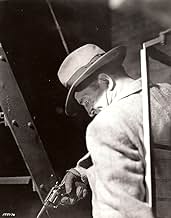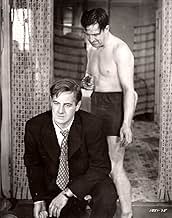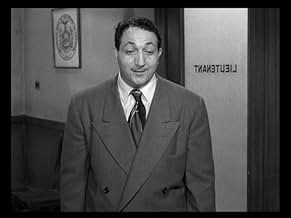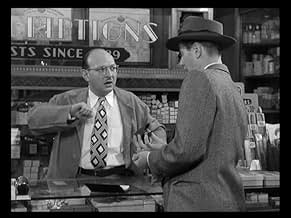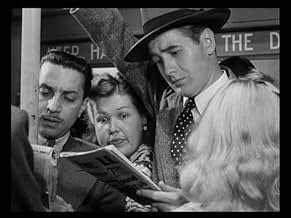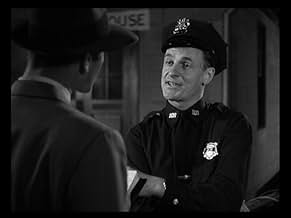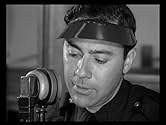VALUTAZIONE IMDb
7,5/10
16.370
LA TUA VALUTAZIONE
Segui una panoramica dettagliata di un'indagine su un omicidio per le strade di New York.Segui una panoramica dettagliata di un'indagine su un omicidio per le strade di New York.Segui una panoramica dettagliata di un'indagine su un omicidio per le strade di New York.
- Vincitore di 2 Oscar
- 6 vittorie e 5 candidature totali
Ted de Corsia
- Willy Garzah
- (as Ted De Corsia)
Mark Hellinger
- Narrator
- (voce)
Jean Adair
- Little Old Lady
- (non citato nei titoli originali)
Celia Adler
- Dress Shop Proprietress
- (non citato nei titoli originali)
Janie Alexander
- Girl
- (non citato nei titoli originali)
Joyce Allen
- Shopgirl
- (non citato nei titoli originali)
Beverly Bayne
- Mrs. Stoneman
- (non citato nei titoli originali)
Recensioni in evidenza
This is a real original and just about everybody involved knows it. A documentary style police drama with real New York locations -- "Nothing was shot in a studio!" And it does capture New York City, circa 1947, entering a late florescent age. Many of the shots were "stolen," taken on real streets from a van with tinted windows, with only the principal actors knowing that a movie was being made.
White collar workers all wear suits and ties. There is a sidewalk salesman hawking neckties. An ice man with those over-sized calipers. A milkman driving a horse and wagon. A Kosher Deli. Little girls playing jump rope -- "Out goes the doctor, out goes the nurse, out goes the lady with the alligator purse." Kids on swings. People reading newspapers over someone else's shoulder while jolting along on the subway. A shootout on a tower of the Williamsberg Bridge. A blind man and his dog. Stillman's Gym with two professional wrestlers being coached in how to register pain. Two girls gawking at a wedding dress in a shop window and mooning over "Frankie." Ethnic people -- Italians, Irish, Jewish, Polish. Accents -- "A boxer-fighter maybe? What do I know?" "Eh, bene, bene -- encore." Scrubby walnut trees in brick-strewn vacant lots. Working class accents mostly, including that of the narrator, Mark Hellinger. Nobody is black or Puerto Rican. The taxi drivers speak English. No bums or dopers. It's all here, or rather it was all there.
Now, of course, it's all a little familiar because we've gotten used to location shooting and wince when shots are obviously studio made. But this was new at the time and is still enjoyable to watch.
The performances are adequate. Don Taylor is bland and doesn't have any accent but he's easy to identify with, at least for me, because he's so pleasant and handsome. Barry Fitzgerald has an oddly creased face and crudely shaped cranium. His smile is almost a mile wide, a caricature of itself, a lovable guy. Howard Duff is -- well, Howard Duff, a liar and a thief. Ted deCorsia is great. We first meet him working out in his shabby apartment, flexing and admiring himself in front of the mirror, his body pale and flabby, a shock of coarse black hair over his sweating forehead. And that voice, like a coffee grinder. And check out the list of supporting actors. Wow. Arthur O'Connell, Nehemia Persoff, James Gregory, inter alia.
The story itself isn't very much. Rather routine. Could have been a good radio drama of the sort that were popular at the time -- "Suspense" or "The Whistler" or "Inner Sanctum." And the narrator's voice-over sometimes creaks at the joints as it strains for hard-boiled sonority -- "Yesterday she was just another pretty face. This morning she's the marmalade on everybody's toast." (That line kills me.)
And, I have to admit, that it paints a kind of pretty picture of police procedures. Barry Fitzgerald in particular is folksy, humorous, and compassionate. I kept waiting for him to remove his pipe and mutter, "Ego te absolvo." The police offices look too CLEAN. There are no dents in the wall from suspects having their heads slammed against it. Every surface seems too recently to have been painted. Suspects who shout angrily at their police interrogators and are obviously lying are just politely reasoned with. It was a time of relative civility. The dective's job is to maintain that civility. Like a doctor, he isolated the criminal who functions as a kind of disease. The city wasn't yet the vicious game preserve it was to become in the 60s. At the end, isolated, the murdere is perched high atop the Williamburg Bridge and there are minuscule dots in white below him, playing tennnis, oblivious to the presence of the "other."
In a neat little touch, the cops are examining the scene of the crime and have found a few stray long hairs. From behind, Fitzgerald leans over the rather mopey middle-aged neighbor on the couch an compares the hair sample to hers. She looks around in surprise. "Er, don't mind me," says Fitzgerald, "I was only admiring your lovely hair." The neighbor clutches her hands together with delight and gazes up at him with an adoring dimpled smile. Fitzgerald pauses a moment, clears his throat, and hurries away.
Well, okay. This might have been "gritty" at the time but now it's just an interesting picture, a little glossy maybe, but a lot of fun, and ahead of its time with that location shooting by Daniels.
White collar workers all wear suits and ties. There is a sidewalk salesman hawking neckties. An ice man with those over-sized calipers. A milkman driving a horse and wagon. A Kosher Deli. Little girls playing jump rope -- "Out goes the doctor, out goes the nurse, out goes the lady with the alligator purse." Kids on swings. People reading newspapers over someone else's shoulder while jolting along on the subway. A shootout on a tower of the Williamsberg Bridge. A blind man and his dog. Stillman's Gym with two professional wrestlers being coached in how to register pain. Two girls gawking at a wedding dress in a shop window and mooning over "Frankie." Ethnic people -- Italians, Irish, Jewish, Polish. Accents -- "A boxer-fighter maybe? What do I know?" "Eh, bene, bene -- encore." Scrubby walnut trees in brick-strewn vacant lots. Working class accents mostly, including that of the narrator, Mark Hellinger. Nobody is black or Puerto Rican. The taxi drivers speak English. No bums or dopers. It's all here, or rather it was all there.
Now, of course, it's all a little familiar because we've gotten used to location shooting and wince when shots are obviously studio made. But this was new at the time and is still enjoyable to watch.
The performances are adequate. Don Taylor is bland and doesn't have any accent but he's easy to identify with, at least for me, because he's so pleasant and handsome. Barry Fitzgerald has an oddly creased face and crudely shaped cranium. His smile is almost a mile wide, a caricature of itself, a lovable guy. Howard Duff is -- well, Howard Duff, a liar and a thief. Ted deCorsia is great. We first meet him working out in his shabby apartment, flexing and admiring himself in front of the mirror, his body pale and flabby, a shock of coarse black hair over his sweating forehead. And that voice, like a coffee grinder. And check out the list of supporting actors. Wow. Arthur O'Connell, Nehemia Persoff, James Gregory, inter alia.
The story itself isn't very much. Rather routine. Could have been a good radio drama of the sort that were popular at the time -- "Suspense" or "The Whistler" or "Inner Sanctum." And the narrator's voice-over sometimes creaks at the joints as it strains for hard-boiled sonority -- "Yesterday she was just another pretty face. This morning she's the marmalade on everybody's toast." (That line kills me.)
And, I have to admit, that it paints a kind of pretty picture of police procedures. Barry Fitzgerald in particular is folksy, humorous, and compassionate. I kept waiting for him to remove his pipe and mutter, "Ego te absolvo." The police offices look too CLEAN. There are no dents in the wall from suspects having their heads slammed against it. Every surface seems too recently to have been painted. Suspects who shout angrily at their police interrogators and are obviously lying are just politely reasoned with. It was a time of relative civility. The dective's job is to maintain that civility. Like a doctor, he isolated the criminal who functions as a kind of disease. The city wasn't yet the vicious game preserve it was to become in the 60s. At the end, isolated, the murdere is perched high atop the Williamburg Bridge and there are minuscule dots in white below him, playing tennnis, oblivious to the presence of the "other."
In a neat little touch, the cops are examining the scene of the crime and have found a few stray long hairs. From behind, Fitzgerald leans over the rather mopey middle-aged neighbor on the couch an compares the hair sample to hers. She looks around in surprise. "Er, don't mind me," says Fitzgerald, "I was only admiring your lovely hair." The neighbor clutches her hands together with delight and gazes up at him with an adoring dimpled smile. Fitzgerald pauses a moment, clears his throat, and hurries away.
Well, okay. This might have been "gritty" at the time but now it's just an interesting picture, a little glossy maybe, but a lot of fun, and ahead of its time with that location shooting by Daniels.
That's just what the producer, Mark Hellinger does. He tries to make it clear from the introduction that this is not your average movie. It is not. This entire production tries to accomplish one thing - authenticity. And for the most part, it succeeds.
Before I get to what's right about this movie, let me mention a few of the things that are wrong. Ted DeCorsia overacts. He always overacts. Howard Duff's character, Frankie Niles, is supposed to be a streetwise grifter. How the hell could he be dumb enough to get himself in as many pickles as he did. Anybody who has ever been around the block would know better than to lie to the cops about everything. Just lie about the important things and tell the truth when it won't hurt you. If this guy is a sociopath, he's the dumbest one in town. Although most of the accents are on the money, the incidental dialogue injected into some of the scenes sounds forced and phony. In fact, it sounds like Hollywood trying to sound like New York. Mark Hellinger's narration, by comparison, is not only authentic, it's practically Damon Runyonesque.
Now - what's right. Practically everything else. The location photography is the New York I remember as a kid. While I was watching some of the hot summer scenes downtown, I could practically smell the asphalt, melting tar, and garbage. Don Taylor's brick duplex in Queens was just the kind of house that every struggling family on the wrong side of Brooklyn aspired to.
I won't comment on the story except to say, it's an entirely believable crime story. I seem to remember Barry Fitzgerald playing a similar role in Union Station. Reminds one of the old days when most of the cops were Irish - and New York was really New York.
Before I get to what's right about this movie, let me mention a few of the things that are wrong. Ted DeCorsia overacts. He always overacts. Howard Duff's character, Frankie Niles, is supposed to be a streetwise grifter. How the hell could he be dumb enough to get himself in as many pickles as he did. Anybody who has ever been around the block would know better than to lie to the cops about everything. Just lie about the important things and tell the truth when it won't hurt you. If this guy is a sociopath, he's the dumbest one in town. Although most of the accents are on the money, the incidental dialogue injected into some of the scenes sounds forced and phony. In fact, it sounds like Hollywood trying to sound like New York. Mark Hellinger's narration, by comparison, is not only authentic, it's practically Damon Runyonesque.
Now - what's right. Practically everything else. The location photography is the New York I remember as a kid. While I was watching some of the hot summer scenes downtown, I could practically smell the asphalt, melting tar, and garbage. Don Taylor's brick duplex in Queens was just the kind of house that every struggling family on the wrong side of Brooklyn aspired to.
I won't comment on the story except to say, it's an entirely believable crime story. I seem to remember Barry Fitzgerald playing a similar role in Union Station. Reminds one of the old days when most of the cops were Irish - and New York was really New York.
Can film noir work in broad daylight - surely a contradiction in terms..? Well, here, it's attempted and largely pulled off by director Jules Dassin with a down-to-earth almost documentary realism which fully involves the viewer in the action as the well-known tag-line "1 of 8,000,000 stories" (the murder of a pretty female immigrant who's fallen into bad company and criminal habits) is played out over a three-day period in a sunny summery New York cityscape. William Daniels' excellent photography captures a city constantly on the move with its own citizens as accidental extras and actual locations as would-be film-sets. Just as effective is the natural vernacular dialogue with some great one-liners thrown in - none better than Barry Fitzgerald seemingly admiring the rear view of a retreating beautiful female suspect with the remark to a junior colleague "Beautiful long legs she has, wouldn't you say?" to which the underling readily concurs only for old pro Fitzgerald to snap "Keep them in sight for the next 48 hours!" detailing a tail on her. There's also another great scene where the murdered girl's mother berates to all and sundry her dead daughter for her reckless lifestyle and bringing of shame onto her family right up until she is taken to identify the corpse where she breaks down uncontrollably, her maternal feelings restored. The murder tale is slightly convoluted but reasonably easy to follow, no contrived clever-clever plotting here, just an everyday relatively uncomplicated murder, solved by routine police work which makes the headlines due to the beauty of the victim. There's close attention paid to forensics and even the insertion of scenes where perennial sad hoaxers come forward to either claim to solve the murder or even confess to it. The acting is mostly good, Fitzgerald is dapper and spot-on as the world-weary 'tec and his supporting officers all acquit themselves well too. The playing however of some of the criminals gets a little overwrought at times and jars the mood slightly. The film arrives at a reasonably exciting conclusion high above Williamsburg Bridge before the city goes back to sleep awaiting its next story... All done and dusted in 90 very watchable minutes, this is a very entertaining film-blanc I suppose you'd have to call it.
There are two styles of Film Noir. Fueled by writers like James M. Cain, Dashiell Hammett, and Raymond Chandler, the first style emerged in the 1940s and was characterized by a cynical, often witty tone; anti-heroes, dangerous women, and assorted criminal elements; and complex plots that emphasized betrayal and moral ambiguity. It was also photographed in a remarkable visual style that combined glossy production values with atmospheric emphasis on light and shadow--and films like THE MALTESE FALCON, THIS GUN FOR HIRE, MILDRED PIERCE, THE BLUE DAHLIA, and DOUBLE INDEMNITY remain great classics of their kind.
But after World War II public taste began to change. Things that could only be hinted at in earlier films could now be more directly stated, and as audiences clamored for a more gritty realism the glossy sophistication of 1940s Noir fell out of fashion. The result was a new style of Noir--photographed in a grainier way, more direct, more brutal, and even less sympathetic to its characters. And the 1948 THE NAKED CITY was among the first to turn the tide. The sophisticated gumshoe, slinky gun moll, and glossy production values were gone; this film felt more like something you might read in a particularly lurid "true detective" tabloid.
In an era when most films were shot on Hollywood backlots, THE NAKED CITY was actually filmed in New York--and while filmmakers could film with hidden cameras sound technology of the day posed a problem. But producer Mark Hellinger turned the problem into an asset: the film would be narrated, adding to the documentary-like style of the cinematography and story. (Hellinger performed the narrative himself, and his sharp delivery is extremely effective.) The story itself reads very much like a police report, following NYPD detectives as they seek to solve a dress model's murder.
For 1948 it was innovative stuff-but like many innovative films it falters a bit in comparison to later films that improved upon the idea. The direct nature of the plot feels slightly too direct, slightly too simple. The same is true of the performances, which have a slightly flat feel, and although Barry Fitzgerald gives a sterling performance he is very much a Hollywood actor whose style seems slightly out of step alongside the deadpan style of the overall cast. Even so, the pace and drive of the film have tremendous interest, and while you might find yourself criticizing certain aspects you'll still be locked into the movie right to the very end. Particularly recommended for Film Noir addicts, who will be fascinated to see the turning point in the style.
Gary F. Taylor, aka GFT, Amazon Reviewer
But after World War II public taste began to change. Things that could only be hinted at in earlier films could now be more directly stated, and as audiences clamored for a more gritty realism the glossy sophistication of 1940s Noir fell out of fashion. The result was a new style of Noir--photographed in a grainier way, more direct, more brutal, and even less sympathetic to its characters. And the 1948 THE NAKED CITY was among the first to turn the tide. The sophisticated gumshoe, slinky gun moll, and glossy production values were gone; this film felt more like something you might read in a particularly lurid "true detective" tabloid.
In an era when most films were shot on Hollywood backlots, THE NAKED CITY was actually filmed in New York--and while filmmakers could film with hidden cameras sound technology of the day posed a problem. But producer Mark Hellinger turned the problem into an asset: the film would be narrated, adding to the documentary-like style of the cinematography and story. (Hellinger performed the narrative himself, and his sharp delivery is extremely effective.) The story itself reads very much like a police report, following NYPD detectives as they seek to solve a dress model's murder.
For 1948 it was innovative stuff-but like many innovative films it falters a bit in comparison to later films that improved upon the idea. The direct nature of the plot feels slightly too direct, slightly too simple. The same is true of the performances, which have a slightly flat feel, and although Barry Fitzgerald gives a sterling performance he is very much a Hollywood actor whose style seems slightly out of step alongside the deadpan style of the overall cast. Even so, the pace and drive of the film have tremendous interest, and while you might find yourself criticizing certain aspects you'll still be locked into the movie right to the very end. Particularly recommended for Film Noir addicts, who will be fascinated to see the turning point in the style.
Gary F. Taylor, aka GFT, Amazon Reviewer
...New York! This film is presented as a quasi-documentary (it is not). Though the story is fictional, the setting is entirely real - 1948 New York City. And that is the biggest appeal of the picture (I was born and raised there so I may be biased). Some interior shots appear to have been filmed on a sound stage, but the bulk of it is on location. For example, there is a scene filmed in lower Manhattan near Rivington and Norfolk streets. It show's a bustling, thriving "family" neighborhood with well dressed folks and kids playing in the neighborhood. It looks nothing like that now - just a place to pass through to get to somewhere else (though there is a school there now - check google maps and find the intersection - you can see the same building in the opening shot for that scene).
Story-wise, it's a pretty solid film especially considering how dated movies from this period can be. There appears to be a real attempt to make the movie as accurate as possible and goes out of its way to include the methods used in solving modern crimes such as forensics - probably a novelty at the time. The acting is solid throughout. I'm not sure how comfortable I am with the idea of a narrator - on the one hand, it lends authenticity to the documentary feel, but on the other, it can take you "out" of the picture at times. Overall, very worth watching. I give it a thumbs up (can I do that here?)
Story-wise, it's a pretty solid film especially considering how dated movies from this period can be. There appears to be a real attempt to make the movie as accurate as possible and goes out of its way to include the methods used in solving modern crimes such as forensics - probably a novelty at the time. The acting is solid throughout. I'm not sure how comfortable I am with the idea of a narrator - on the one hand, it lends authenticity to the documentary feel, but on the other, it can take you "out" of the picture at times. Overall, very worth watching. I give it a thumbs up (can I do that here?)
Lo sapevi?
- QuizMost of the street scenes were shot on location in New York without the public's knowledge. Photographer William H. Daniels and his uncredited assistant Roy Tripp filmed people on the streets using a hidden camera from the back of an old moving van. Occasionally, a fake newsstand with a hidden camera inside was also set up on the sidewalk to secretly film the actors. Director Jules Dassin hired a juggler to distract the crowds and also hired a man to occasionally climb up on a light post and give a patriotic speech, while waving an American flag to get the crowd's attention.
- BlooperDuring the end pursuit, Garzah walks past a plump, dark-haired lady in a floral dress, pushing a baby in a stroller. As Donahue pursues in a following scene, he passes the same woman, now walking without her baby carriage and her left hand bandaged.
- Curiosità sui creditiThe opening credits are spoken by producer/narrator Mark Hellinger. No credits are seen on the screen.
- ConnessioniFeatured in Visions of Light (1992)
- Colonne sonoreSobre las Olas (Over the Waves)
(1887) (uncredited)
Written by Juventino Rosas
Background music for the girls on swings
I più visti
Accedi per valutare e creare un elenco di titoli salvati per ottenere consigli personalizzati
- How long is The Naked City?Powered by Alexa
Dettagli
- Data di uscita
- Paese di origine
- Lingua
- Celebre anche come
- La ciudad desnuda
- Luoghi delle riprese
- Aziende produttrici
- Vedi altri crediti dell’azienda su IMDbPro
Botteghino
- Lordo Stati Uniti e Canada
- 2.400.000 USD
- Tempo di esecuzione1 ora 36 minuti
- Colore
- Proporzioni
- 1.37 : 1
Contribuisci a questa pagina
Suggerisci una modifica o aggiungi i contenuti mancanti

Divario superiore
By what name was La città nuda (1948) officially released in India in English?
Rispondi

